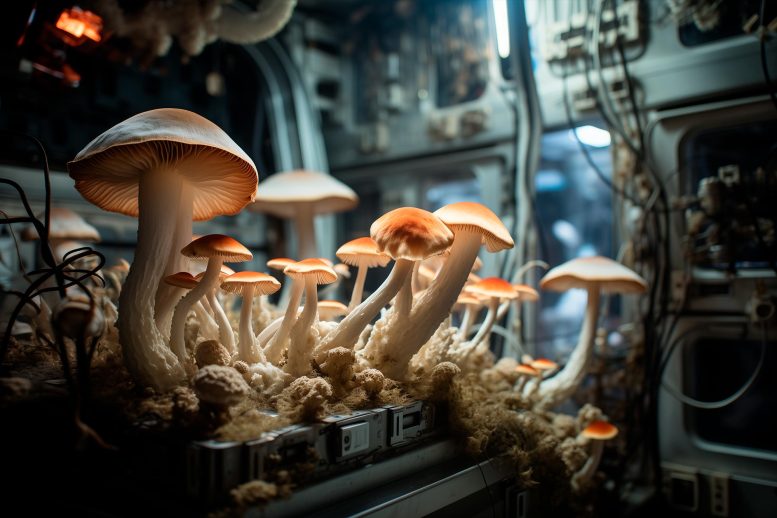As humanity continues to push the boundaries of exploration beyond our own planet, we’re discovering that the universe is not just a vast expanse of lifeless rock and gas. Rather, it’s teeming with potential for discovery, including the surprising presence of microbial life forms such as fungi. Fungi, with their diverse forms and functions, are proving to be valuable companions in our quest to understand space and its potential for sustaining life beyond Earth.
Fungal Pioneers
Fungi have long been recognized for their resilience and adaptability in extreme environments on Earth, from the depths of the ocean to the freezing polar regions. So, it’s no surprise that they’ve also found their way into space. In fact, fungi have been hitching rides on spacecraft since the early days of space exploration.
One of the most notable examples is the Cryptococcus neoformans fungus, which was sent aboard the Space Shuttle Columbia in 1999 as part of the STS-93 mission. This mission aimed to study the effects of microgravity on the growth and virulence of this pathogenic fungus. Researchers discovered that microgravity altered the expression of certain genes in C. neoformans, potentially affecting its pathogenicity. This finding highlighted the importance of understanding how microorganisms behave in space, particularly concerning human health during long-duration missions.

Fungi as Bioindicators
Beyond their potential as pathogens, fungi also serve as valuable bioindicators, providing insights into the health of space habitats. Their growth patterns, metabolism, and responses to environmental stressors can reveal crucial information about the conditions in spacecraft and space stations. Monitoring fungal growth can help astronauts detect changes in air quality, moisture levels, and other factors that could impact their health and safety.
Moreover, fungi play a vital role in the recycling of nutrients and decomposition of organic matter, processes essential for sustaining life in closed ecosystems. Understanding how fungi function in space environments could inform the design of future bioregenerative life support systems, which aim to provide food, water, and oxygen for long-duration space missions.

Fungal Applications in Space
Aside from their role as bioindicators and decomposers, fungi offer several other promising applications for space exploration:
1. Biological Recycling: Fungi could be utilized to recycle organic waste generated by astronauts into valuable resources, such as nutrients for plant growth or even edible biomass.
2. Biomanufacturing: Certain fungi are capable of producing useful compounds, including pharmaceuticals, enzymes, and biofuels. Harnessing their biomanufacturing capabilities in space could enable on-site production of essential supplies. In turn, this reduces the need for costly resupply missions from Earth.
3. Radiation Protection: Some fungi produce melanin, a pigment known for its radiation-absorbing properties. Incorporating melanin-producing fungi into spacecraft materials could help shield astronauts from harmful cosmic radiation during deep space missions.
4. Food Production: Certain species of fungi, such as Pleurotus ostreatus (oyster mushroom), are efficient at converting organic matter into nutritious biomass. Cultivating fungi for food production could supplement astronauts’ diets with fresh, protein-rich sustenance during long missions.
5. Habitat Building: NASA is currently researching the use case of mycelial building blocks for the first human habitat hub. Mycelium is incredibly apt to be dehydrated and condensed for space travel. Once on location, it gets rehydrated to create floors, walls, a ceiling and even furniture. When those first human colonies land, they will have a place to sleep and eat. See more on this exciting aspect in the second half of this webinar.

Challenges and Opportunities
While fungi hold great promise for space exploration, several challenges must be addressed to fully realize their potential:
Microgravity Effects: Understanding how microgravity affects fungal growth and metabolism is crucial for optimizing their performance in space habitats.
Contamination Control: Preventing fungal contamination of spacecraft and habitats is essential to safeguarding the health of astronauts and preserving equipment.
Resource Limitations: Space missions are constrained by limited resources, including space, power, and consumables. Developing efficient fungal cultivation systems that minimize resource usage is essential for sustainable space exploration.

Despite these challenges, the study of fungi in space opens up exciting opportunities for advancing our understanding of microbial life beyond Earth and harnessing its potential for supporting human space exploration. By leveraging the unique capabilities of fungi, we can pave the way for safer, more sustainable long-duration missions to distant destinations in the cosmos. As we continue to explore the final frontier, fungi may prove to be invaluable allies in our quest for interstellar exploration and colonization.
Want to learn about other fungi fun facts? We have you covered with this article. Want to learn more about fungi? Our weekly newsletter is full of fungi facts, news and upcoming activities. Subscribe now.
